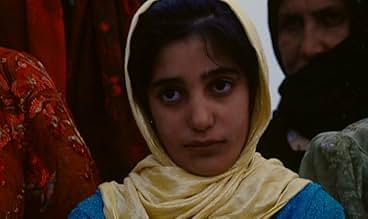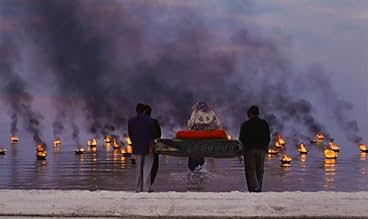IMDb RATING
7.6/10
1.2K
YOUR RATING
Rahmat has been asked to meet the inhabitants of these islands to collect their tears. Although for years people have been giving their tears to Rahmat, no one knows exactly what he has been... Read allRahmat has been asked to meet the inhabitants of these islands to collect their tears. Although for years people have been giving their tears to Rahmat, no one knows exactly what he has been doing with them.Rahmat has been asked to meet the inhabitants of these islands to collect their tears. Although for years people have been giving their tears to Rahmat, no one knows exactly what he has been doing with them.
- Awards
- 4 wins & 4 nominations total
- Director
- Writer
- All cast & crew
- Production, box office & more at IMDbPro
Storyline
Did you know
- TriviaThis film, like Mohammad Rasoulof's other films, has never been screened in Iran.
Featured review
Mohammad Rasoulof's "The White Meadows" is a masterpiece that will creep deep in your skin and will haunt your memory for a long time. The allegory of the film is a punch into the stomach, it's imagery of insuperable beauty and the story line an anthropological journey into the very essence of human societies. The ambiguous main character of the film Rahman, reserves for the spectator a place on his boat. Following him the viewer collects the tears of humans patiently getting immersed in a overwhelming study of human sorrow. In Rahman's boat one glides from island to island beholding speechless the rites, customs and superstitions of an unknown, but very familiar society.
Art, as every human action, requires the combination of scarce means towards the achievement of valued ends. Rasoulof picks as the setting of his film the lake Daryacheh in the north of Iran, which is a landscape of utmost harshness and physical beauty. While the means of the filmmaker seem to be quite limited, Rasoulof exploits tremendously well the physical beauty of the lake. He sets before our eyes an archipelagos of islands and islets and gives us the impression of an endless world from where no escape is possible. In these extremities the director establishes his plot, reconstructing effectively an entire human society. As the movie progresses we get insights in the customs and the institutions of the people, a puzzle that won't be completed until the very last scene . Then, with a masterful regression the film starts again at its very end. The director attains an astonishing cinematic achievement, with very little means at his disposition.
One could claim that Rasoulof, is discovering his own language assimilating elements from Iranian and European Masters. The cinematography of the film is of extraordinary beauty. The director draws on canvases playing with the water, the mistiness, the reflections, the white rugged rock and the salty scenery to produce a stunning and dreamlike world. The imagery functions on a poetic level by way of symbols and allegory. Some of the images are so exceptional than converted into photography or poetry they could retain their forcefulness. The director moves slowly and carefully from a scene to another allowing us the time to sit comfortably in the stern of Rahman's boat and reflect on the nature of his world. The more we behold the people the more we can envisage how it would feel like to be among them. The journey that we undertake is a vicarious experience immersed into visceral emotions. In the White Meadows, Rasoulof is possibly learning from currents and directors like the Italian Neorealism, Kurastami, Tarkovski and Angelopoulos, however his attainment belongs distinguishably to Rasoulof.
The White Meadows can be seen as an allegory to the current political regime of Iran, nonetheless the message conveyed by it is universal. The characters of the film could stand as the prototypes of a disutopian Platonic state. Rahman, the main character, remains an illegible until the very end of the film. The rules of his profession are simple. He wanders like a country-side doctor ,to places where people are mourning, collecting their tears, unaffected by the plights of his patients. During the film, one might try in vain to find the driving elements of his behavior. The laymen of this society appear to be fearful and extremely concerned with their own superstitions to have any critical thought. A little renegade who represents the curious, passionate and adventurous mind and an artist who sees the world differently from his fellows are sacrificed in a setting that could be inspired by ancient Greek tragedy. The director was actually arrested along with Panahi on the 1st of March 2010.
In my humble view, Rasoulof, in his 37,has directed a masterpiece of utmost intricacy and aesthetic value. His work is one of those destined to reside in our memory for a long time. Thus, I hope that the White Meadows will find their way to the movie theaters, our memories and ultimately film history . In the meanwhile, I hope that Rasoulof will continue to deliver us great films and to ameliorate his artistic language, despite the difficulties encountered in his homeland.
Art, as every human action, requires the combination of scarce means towards the achievement of valued ends. Rasoulof picks as the setting of his film the lake Daryacheh in the north of Iran, which is a landscape of utmost harshness and physical beauty. While the means of the filmmaker seem to be quite limited, Rasoulof exploits tremendously well the physical beauty of the lake. He sets before our eyes an archipelagos of islands and islets and gives us the impression of an endless world from where no escape is possible. In these extremities the director establishes his plot, reconstructing effectively an entire human society. As the movie progresses we get insights in the customs and the institutions of the people, a puzzle that won't be completed until the very last scene . Then, with a masterful regression the film starts again at its very end. The director attains an astonishing cinematic achievement, with very little means at his disposition.
One could claim that Rasoulof, is discovering his own language assimilating elements from Iranian and European Masters. The cinematography of the film is of extraordinary beauty. The director draws on canvases playing with the water, the mistiness, the reflections, the white rugged rock and the salty scenery to produce a stunning and dreamlike world. The imagery functions on a poetic level by way of symbols and allegory. Some of the images are so exceptional than converted into photography or poetry they could retain their forcefulness. The director moves slowly and carefully from a scene to another allowing us the time to sit comfortably in the stern of Rahman's boat and reflect on the nature of his world. The more we behold the people the more we can envisage how it would feel like to be among them. The journey that we undertake is a vicarious experience immersed into visceral emotions. In the White Meadows, Rasoulof is possibly learning from currents and directors like the Italian Neorealism, Kurastami, Tarkovski and Angelopoulos, however his attainment belongs distinguishably to Rasoulof.
The White Meadows can be seen as an allegory to the current political regime of Iran, nonetheless the message conveyed by it is universal. The characters of the film could stand as the prototypes of a disutopian Platonic state. Rahman, the main character, remains an illegible until the very end of the film. The rules of his profession are simple. He wanders like a country-side doctor ,to places where people are mourning, collecting their tears, unaffected by the plights of his patients. During the film, one might try in vain to find the driving elements of his behavior. The laymen of this society appear to be fearful and extremely concerned with their own superstitions to have any critical thought. A little renegade who represents the curious, passionate and adventurous mind and an artist who sees the world differently from his fellows are sacrificed in a setting that could be inspired by ancient Greek tragedy. The director was actually arrested along with Panahi on the 1st of March 2010.
In my humble view, Rasoulof, in his 37,has directed a masterpiece of utmost intricacy and aesthetic value. His work is one of those destined to reside in our memory for a long time. Thus, I hope that the White Meadows will find their way to the movie theaters, our memories and ultimately film history . In the meanwhile, I hope that Rasoulof will continue to deliver us great films and to ameliorate his artistic language, despite the difficulties encountered in his homeland.
- pantelispa
- Jun 19, 2010
- Permalink
- How long is The White Meadows?Powered by Alexa
Details
- Runtime1 hour 32 minutes
- Color
Contribute to this page
Suggest an edit or add missing content




















